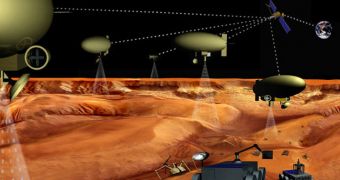Scientists at the California Institute of Technology (Caltech), in Pasadena, believe that we are on the verge of a new paradigm shift in space exploration, one that could see the replacement of single robotic explorers on or around a planet or moon with a fleet of instruments, all of them in constant communication with each other. Visiting Associate Professor of Physics Wolfgang Fink believes that the next mission to Saturn's moon Titan could be made up of orbiters above the surface, amphibious robots to explore its hydrocarbon lakes, as well as the usual, ground-based rovers.
“The way we explore tomorrow will be unlike any cup of tea we've ever tasted. We are departing from traditional approaches of a single robotic spacecraft with no redundancy that is Earth-commanded to one that allows for having multiple, expendable low-cost robots that can command themselves or other robots at various locations at the same time,” Fink explains. The expert was recently named the Edward and Maria Keonjian Distinguished Professor in Microelectronics at the University of Arizona in Tucson (UAT), the NASA Caltech-based Jet Propulsion Lab (JPL) reveals in a press release.
Together with experts at UAT and the United States Geological Survey (USGS), Fink and his team are developing an autonomous control piece of software that will be able to find targets of interest on other planets or moons, and then control the robotic fleet in a manner that would ensure the most conclusive data on the target are gathered. Each of the mission components will need to be able to operate both as an individual explorer, and as part of a larger team, Fink explains. “In the future, multiple robots will be in the driver's seat,” he adds.
In the current paradigm, mission controllers are in charge of handling a robotic explorer. This may be suitable for static scientific observations, but the mission is also plagued by not being able to observe live events, such as landslides, cryovolcanic eruption, or methane outgassing events. “This [new] type of exploration is referred to as tier-scalable reconnaissance. It's sort of like commanding a small army of robots operating in space, in the air and on the ground simultaneously,” Fink says. The new mission proposal for Titan envisions the use of an orbiter, an air balloon and a rover or lake lander.
“We are basically heading toward making robots that command other robots. One day an entire fleet of robots will be autonomously commanded at once. This armada of robots will be our eyes, ears, arms and legs in space, in the air, and on the ground, capable of responding to their environment without us, to explore and embrace the unknown,” he concludes. Fink is also the director of the Caltech Visual and Autonomous Exploration Systems Research Laboratory, where the new exploration paradigm was developed.

 14 DAY TRIAL //
14 DAY TRIAL //